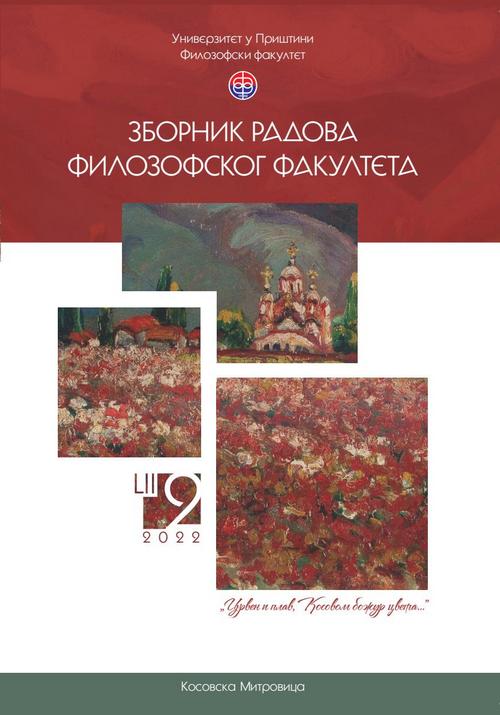Популарна култура и интеркултурална комуникација: глас и ехо
Sažetak
Примарни циљ популарне културе као доминантног облика културе у ХХI веку требало би да буде
спајање људи у културолошку синергију. Популарна култура као таква требало би да инсистира на богатству различитости, а не на стереотипима, као што је данас то случај. Овај рад ће анализирати појмове комуникације, културе, интеркултуралне комуникације, културолошког империјализма, као и утицај популарне културе на интеркултуралну комуникацију.
Reference
Bakić-Mirić, N. (2020). Introducing Translation as Intercultural Communication. Kosovska Mitrovica: Filozofski fakultet.
Bakić-Mirić, N. (2012). An Integrated Approach to Intercultural Communication. Newcastle upon Tyne: Cambridge Scholars Publishing.
Brummet, B. (1994). Rhetoric in Popular Culture. New York: St. Martin’s Press.
Danesi, M. (2019). Popular Culture: Introductory Perspectives. New York – London: Rowman & Littlefield.
Dayer, R. (1993). The Matter of Images: Essays on Representations. New York: Routledge.
Fiske, J. (2011). Understanding Popular Culture. London – New York: Routledge.
Hall, E. T. (1990). The Silent Language. New York: Random House.
Hall, S. (1980). Encoding/Decoding. In: S. Hall, D. Hobson, A. Lowes, P. Willis (Eds.). Culture, Media, Language (128–138). London: Hutchinson.
Hofstede, G. J., Pedersen, P. B., & Hofstede, G. (2002). Exploring Culture. Maine: Intercultural Press.
Jandt, F. E. (2021). An Introduction to Intercultural Communication: Identities in the Global Community. Thousand Oaks, CA: SAGE.
Kadarisman, A. E. (2015). Linguistic Relativity, Cultural Relativity, and Foreign Language Teaching. TEFLIN Journal, 16 (1), 1–25.
Kotz, E. & Liebes, T. (1987). Decoding Dallas. Notes from a Cross-Cultural Study. In: H. Newcomb (Ed.). Television: The Critical View. New York: Oxford University Press.
Lucas, E. (2020, October 26). The Borat Films are Hilarious – For Some. The Sunday Times. Retrieved from: https://www.thetimes.co.uk/article/the-borat-films-are-hilarious-for-some-rnc38whb3Lustig
Lustig, M. W. & Koester, J. (2018). Intercultural Competence: Interpersonal Communication Across Cultures. Boston, MA: Pearson.
Martin, J. N. & Nakayama, T. K. (2018). Intercultural Communication in Contexts. New York: McGraw Hill Education.
Merrit, B. D. (2000). Illusive Reflections: African American Women on Primetime Television. In: A. Gonzales, M. Houston, V. Chen (Eds.), Our Voices (47–53). Los Angeles: Roxbury.
Neuliep, J. W. (2018). Intercultural Communication: A Contextual Approach. Thousand Oaks, CA: SAGE.
Newcomb, H. & Hirsch, P. M. (1987). Television and Cultural Forum. In: H. Newcomb (Еd.), Television: The Critical View. New York: Oxford University Press.
Samovar, L. A., Porter, R. E., McDaniel, E. R., Roy, C. S. (2017). Communication Between Cultures. Boston: Cengage Learning.
Sorrells, K. (2021). Intercultural Communication: Globalization and Social Justice. Los Angeles: SAGE.
Storey, J. (2021). Cultural Theory and Popular Culture. London – New York: Routledge.
Tan, A., Fujiioka, F. & Tan, G. (2000). Television Use, Stereotypes of African Americans and Opinions on Affirmative Action: An Affective Model of Policy Reasoning. Communication Monographs, 67 (4), 362–371.
Ting-Toomey, S. & Dorjee, T. (2019). Communicating Across Cultures. London – New York: The Guilford Press.
Tomlinson, J. (1991). Globalization and Culture. Chicago: The University of Chicago Press.
Tomlinson, Ј. (1999). Cultural Imperialism. London – New York: Continuum.
Detalji u vezi sa uređivačkom politikom, uključujući i autorska prava, dostupni su na sajtu SCIndeks.
http://scindeks.ceon.rs/journalDetails.aspx?issn=0354-3293

